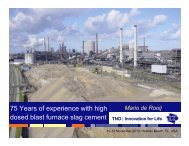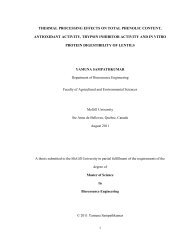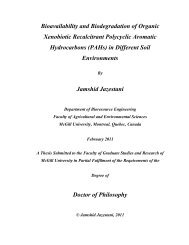Postharvest treatments to reduce chilling injury symptoms in stored ...
Postharvest treatments to reduce chilling injury symptoms in stored ...
Postharvest treatments to reduce chilling injury symptoms in stored ...
You also want an ePaper? Increase the reach of your titles
YUMPU automatically turns print PDFs into web optimized ePapers that Google loves.
3.5.2 Quality of mangoes after s<strong>to</strong>rage<br />
The quality of the control and the CI-treated mangoes was assessed after 21 days<br />
of s<strong>to</strong>rage at the prescribed temperatures and the results are presented and discussed<br />
below.<br />
(a) Sk<strong>in</strong> and flesh color<br />
As shown <strong>in</strong> Tables 3.2 and 3.3, noticeable changes <strong>in</strong> the sk<strong>in</strong> and flesh color<br />
occurred dur<strong>in</strong>g s<strong>to</strong>rage. After 21 days of s<strong>to</strong>rage, mangoes sk<strong>in</strong> was darker (lower L*<br />
value), slightly more red (greater a* value) and less yellow (lower b* value). Comparison<br />
among the four CI-<strong>treatments</strong> tested (Table 3.4) <strong>in</strong>dicated that the HWT yielded the<br />
lightest colored fruits with more red and yellow. MJ-treated fruits were slightly bright<br />
(greater L* value) more yellow <strong>in</strong> sk<strong>in</strong> color as compare <strong>to</strong> control fruits while the<br />
difference between MJ and DPA CI-treated fruits were not significant at 0.05 level.<br />
Aside from this observation, no specific trend could be derived from the data.<br />
As shown <strong>in</strong> Table 3.5 the analysis performed <strong>to</strong> assess the effects of s<strong>to</strong>rage<br />
temperatures on mango sk<strong>in</strong> color did <strong>in</strong>dicate that fruits s<strong>to</strong>red at 1 ºC were brighter<br />
(greater L* value), slightly more red (greater a* value) and less yellow (lower b* value)<br />
<strong>in</strong> color. Difference <strong>in</strong> L*, a* and b* values among 7 and 10 ºC were small and not<br />
significant at 0.05 level. No specific trends could be derived from the data.<br />
Color measurements made on the flesh portion of the fruits <strong>in</strong>dicated that after<br />
s<strong>to</strong>rage (Tables 3.2 and 3.3), the color was not as bright, less red and less yellow as that<br />
measured on fruits before s<strong>to</strong>rage. As shown <strong>in</strong> Table 3.4, it is <strong>in</strong>terest<strong>in</strong>g <strong>to</strong> note that the<br />
best color retention was observed on the control treatment with both the L* and b* values<br />
significantly greater than those of other CI-<strong>treatments</strong>. Differences <strong>in</strong> L* and a* among<br />
the three other CI-<strong>treatments</strong> were small and most were not significant at the 0.05 level.<br />
The flesh portion of the HW CI-treated fruits was significantly more yellow than control<br />
or DPA CI-treated fruits, but not significantly different from MJ CI-treated fruits. As<br />
shown <strong>in</strong> Table 3.5, best flesh color retention was observed on mangoes s<strong>to</strong>red for 21<br />
days at 1 ºC with both L* and a* values significantly greater than those observed at the<br />
other temperatures. In most cases, differences <strong>in</strong> flesh color expressed as a* and b* for<br />
the mangoes s<strong>to</strong>red for 21 days at 4, 7 or 10 ºC were not significant at the 0.05 level.<br />
33









